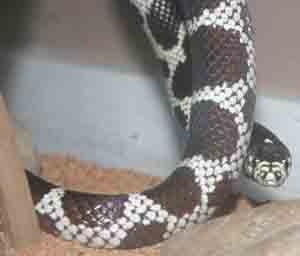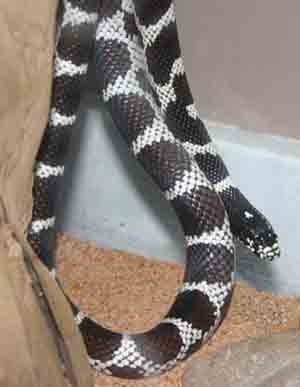King Snakes - Lampropeltis getula
The common Kingsnake is distributed throughout the southern regions of the United States as far North as Southern Oregon and New Jersey and as far south as Southern Florida and Northern Mexico. Its habitat is various, but in general where there are rodents and water, the common Kingsnake may be found.
Just as its habitat is various, so are the coloration and patterns of the Kingsnake. The Kingsnake may appear black with white bands (California Kingsnake), all black (Mexican Kingsnake), yellow with brown and black patterns (South Florida Kingsnake), black with yellow specks (Speckled Kingsnake of Texas), or red with white and black bands (Arizona Mountain Kingsnake). Head is small and not distinct from the body. They are smooth scaled with a variety of colors and patterns. Kingsnakes are constrictors and are usually active at dawn and dusk.
DO NOT FEED WILD ANIMALS TO YOUR PET – THEY MAY CARRY DISEASES THAT COULD BE DEADLY TO YOUR PET
Wild Kings are loners and prey on any other snake they meet including Rattle Snakes and other King Snakes. They only come together to breed. For these reasons Kings should always be kept singly.
Average Size - Length of adults is 4 feet - 6 feet depending on the sub species
Life Span - Kings have the potential to live for over 18 years. Records exist of Kings over 21 years of age. The snake pictured as of 2007 is seven years old.
Diet - Mice, small rats and other small rodents
Feeding - Feed mice appropriate to the size of their mouth. Hatchlings start on pink mice every 5-6 days and graduate up to an adult mouse every 7-10 days as they grow. Very large snakes may require 2 adult mice per feed. They will also take other small rodents such as gerbils, hamsters and young rats. Wild Kings also feed on amphibians, reptiles (including other snakes) and birds. There is no need at all to feed your snake with live food. Shop brought frozen rodents are available from most pet shops and if well  thawed to room temperature these make an excellent all round food for your snake, which wont bite back and injure the snake. Wild rodents carry parasites and should be avoided at all times. Never handle your snake straight after a feed as it will regurgitate it`s meal. thawed to room temperature these make an excellent all round food for your snake, which wont bite back and injure the snake. Wild rodents carry parasites and should be avoided at all times. Never handle your snake straight after a feed as it will regurgitate it`s meal.
Substrate - Plain paper is inexpensive and easily changed when soiled. Other Choices are outdoor carpeting or aquarium gravel, coconut fiber or just paper towles. A shelter or hide box is needed so the snake has a dark area to rest and feel secure. A rock or branch should be included to give an abrasive spot for the snake to rub upon to help with shedding.
Housing - The enclosure you select must have a tightly fitting, locking, top. Available commercially are a variety of glass enclosures with tops consisting of screen mesh and a hinged glass door which locks into place with a small swing latch. Available now are also locking screen tops which can be put on previously purchased tanks. With either of these enclosures, check the give of the tops before you place your snake inside and walk away. Snakes can squeeze themselves through impossibly tight spaces. Any gaps due to "give" in the doors or tops can be reduced significantly by fitting aquarium airline tubing all around the opening.
Hatchlings may be housed in a ten gallon enclosures. Medium sized adults may be housed in twenty gallon  enclosures, but you might as well get hatchlings and young adults set up in a tank large enough for a full grown one. The longer and larger snakes should be housed in a 60 gallon enclosure. Try to get high-sided enclosures so that you may put in some vertical climbing and above-the-floor basking areas. King snakes, like all the other snakes in the family Colubridae (typically, non-venomous snakes considered to be more highly evolved than the boas and pythons), have only one functioning lung. Due to the lack of space inside the confines of their rib cage, all organs are elongated and so there is now room for only one working lung. Their left lung is still there, withered to a vestigial stub. Because of this somewhat reduced lung capacity, and the fact that when such snakes cannot stretch fully out on a regular basis, they are prone to respiratory infections. For this reason, it is important to give the snake as much stretching room as possible. enclosures, but you might as well get hatchlings and young adults set up in a tank large enough for a full grown one. The longer and larger snakes should be housed in a 60 gallon enclosure. Try to get high-sided enclosures so that you may put in some vertical climbing and above-the-floor basking areas. King snakes, like all the other snakes in the family Colubridae (typically, non-venomous snakes considered to be more highly evolved than the boas and pythons), have only one functioning lung. Due to the lack of space inside the confines of their rib cage, all organs are elongated and so there is now room for only one working lung. Their left lung is still there, withered to a vestigial stub. Because of this somewhat reduced lung capacity, and the fact that when such snakes cannot stretch fully out on a regular basis, they are prone to respiratory infections. For this reason, it is important to give the snake as much stretching room as possible.
Habitat - Humidity should be lower for king snakes as these are desert dwelling snakes. Between 45 -50 is best
Temperature - Racks and tanks should be set up to have a good heat gradient of approximately 90 F on the hot side and 70 F on the cool side. Heat tape or under tank heaters as well as a ceramic heater is recommended to achieve this.
Lighting - Snakes need a photoperiod light cycle; provide 8-12 hours of light daily; do not leave white light on at all times; to view snakes at night, use a black or infrared light. In addition to the basking light, a full spectrum reptile UVA/UVB light should be provided. Exposure to UVA/UVB is necessary for proper calcium metabolism, and also appears to have other benefits to overall health such as improving appetite.
Water - Your snake requires CLEAN drinking water at all times. This should be refreshed daily. King Snakes also like to bathe, but continued emersion can lead to skin problems and large amounts of water in the cage can lead to high humidity resulting in lung problems. A large half filled bowl of water can be offered for soaking.
Recommended Supplies:
- Habitat with secure lid
- Thermometer
- Misting bottle
- Humidity gauge
- Book about King snakes
- Light timer
|
- Substrate
- Hide box or driftwood
- Water dish
- Undertank heat source
- Incandescent light or ceramic heater
| Normal Behavior and Interaction As snake gets ready to shed, eyes will turn a milky blue over the course of a few days and body color will start to dull and develop a whitish sheen Appetite may diminish during winter months
Habitat Maintenance Change water daily. Thoroughly clean the tank at least once week: set snake aside in a secure habitat - a snake/reptile bag works well; scrub the tank and furnishings with a 3% bleach solution; rinse thoroughly with water, removing all smell of bleach; dry the tank and furnishings; and add clean substrate
Grooming and Hygiene King snakes will regularly shed their skin; ensure humidity of habitat is at appropriate level to allow your snake to shed properly. To facilitate shedding, bathe snake in a large container that allows snake to immerse its entire body. Always wash your hands before and after touching your snake or habitat contents to help prevent Salmonella and other infectious diseases
Signs of a Healthy Pet:
- Clear eyes (except when shedding)
- Clear nose and mouth
- Body is rounded and full
|
- Active and alert
- Eats regularly
- Healthy skin
| Common Health Issues and Red Flags:
- Wrinkled or rubbed skin
- Vomiting
- Discharge in nose or mouth
|
- Lethargy
- Abnormal feces or urine
- Decreased appetite
|
If you notice any of these signs, please contact your exotic animal veterinarian.
As with all pets in this category, it is important that you find a veterinarian that practices in EXOTICS – this is critical. The typical small animal practitioner may not have sufficient knowledge in this area.
Even this guide is general in nature and should not be used to diagnose your pet.
|


 thawed to room temperature these make an excellent all round food for your snake, which wont bite back and injure the snake. Wild rodents carry parasites and should be avoided at all times. Never handle your snake straight after a feed as it will regurgitate it`s meal.
thawed to room temperature these make an excellent all round food for your snake, which wont bite back and injure the snake. Wild rodents carry parasites and should be avoided at all times. Never handle your snake straight after a feed as it will regurgitate it`s meal.  enclosures, but you might as well get hatchlings and young adults set up in a tank large enough for a full grown one. The longer and larger snakes should be housed in a 60 gallon enclosure. Try to get high-sided enclosures so that you may put in some vertical climbing and above-the-floor basking areas. King snakes, like all the other snakes in the family Colubridae (typically, non-venomous snakes considered to be more highly evolved than the boas and pythons), have only one functioning lung. Due to the lack of space inside the confines of their rib cage, all organs are elongated and so there is now room for only one working lung. Their left lung is still there, withered to a vestigial stub. Because of this somewhat reduced lung capacity, and the fact that when such snakes cannot stretch fully out on a regular basis, they are prone to respiratory infections. For this reason, it is important to give the snake as much stretching room as possible.
enclosures, but you might as well get hatchlings and young adults set up in a tank large enough for a full grown one. The longer and larger snakes should be housed in a 60 gallon enclosure. Try to get high-sided enclosures so that you may put in some vertical climbing and above-the-floor basking areas. King snakes, like all the other snakes in the family Colubridae (typically, non-venomous snakes considered to be more highly evolved than the boas and pythons), have only one functioning lung. Due to the lack of space inside the confines of their rib cage, all organs are elongated and so there is now room for only one working lung. Their left lung is still there, withered to a vestigial stub. Because of this somewhat reduced lung capacity, and the fact that when such snakes cannot stretch fully out on a regular basis, they are prone to respiratory infections. For this reason, it is important to give the snake as much stretching room as possible.